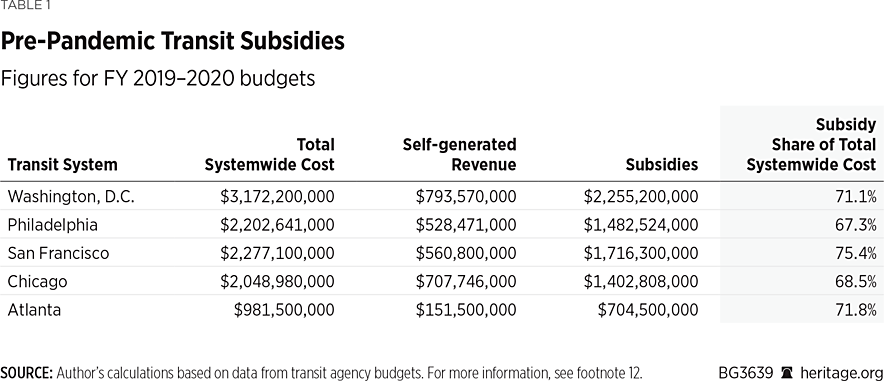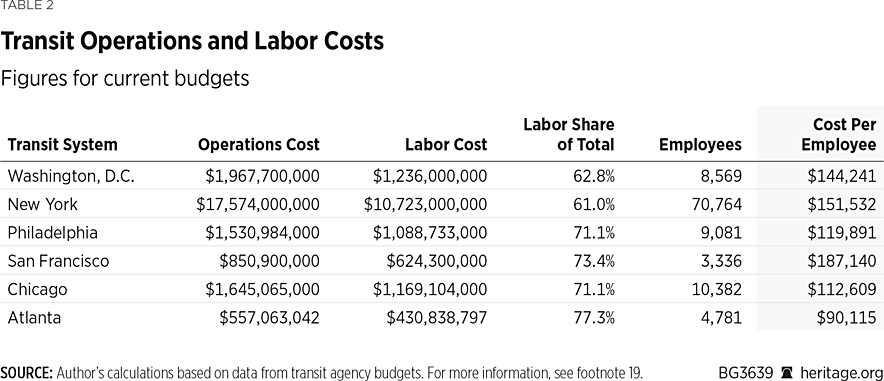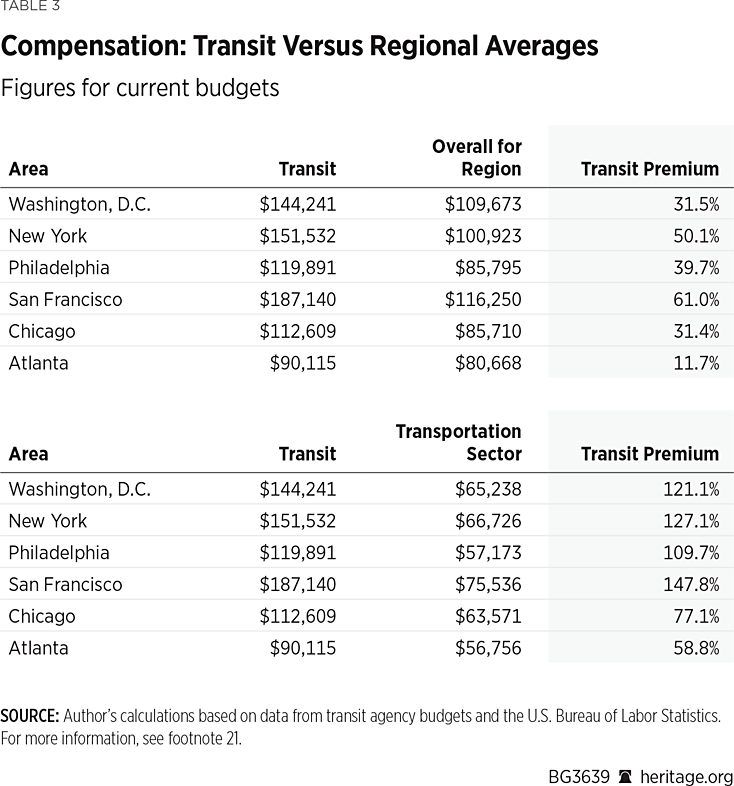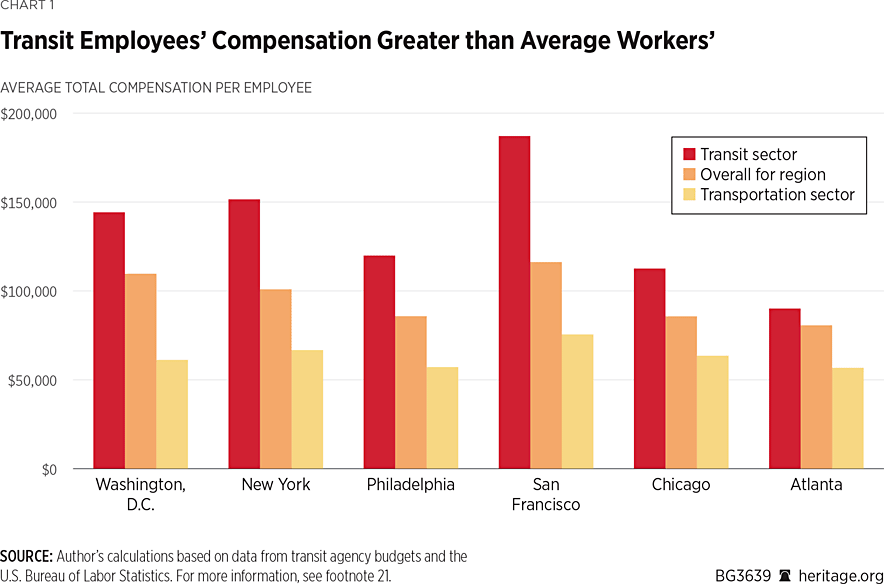The federal government’s primary avenue of spending on infrastructure is through the Highway Trust Fund (HTF), which covers interstate roads, intercity rail, public transit, and more.REF Authorization for programs funded by the HTF expires on September 30, 2021, and both the House and the Senate are working on reauthorization legislation. There is also discussion of an infrastructure spending package that would be in addition to regular HTF activity.
Although the HTF was created in 1956 to fund construction of the interstate highway system, Congress has added a variety of non-highway programs to the fund.REF The largest of these is the Mass Transit Account, which was created in 1982 following pressure from Members representing urban districts.REF Instead of funding roads, the Mass Transit Account subsidizes subway systems, buses, and other local public transportation programs.
While they debate how to handle federal funding for transit this year, it is vital for legislators to be aware of how heavily subsidized transit already is and the extent to which subsidies are being funneled into extraordinarily high employee compensation rather than high levels of service for the general public.REF
Outsized Transit Subsidies
Roughly $10 billion per year of HTF funds are diverted into the Mass Transit Account.REF Since the HTF is designed to be funded by gas tax revenue and derives no funding from transit users, this represents a decades-long cross-subsidy that benefits transit users at the expense of drivers. States are forced to spend a set amount of their HTF allotments on transit based on federal formulas regardless of whether transit is a fit for the areas in question.REF
The HTF’s decades-long account surplus was consumed by overspending, leading to annual deficits and repeated deficit-funded bailouts. This was caused primarily by the transit diversion. From 1984 through 2019, the Mass Transit Account received $169.5 billion in funding, compared to $143.6 billion in general fund bailouts for the HTF over the same period.REF The Department of Transportation’s Federal Transit Administration also receives nearly $3 billion per year through the annual appropriations process, most of which goes toward transit infrastructure.REF
In addition to these regular funds, Congress provided $67 billion to transit agencies through legislation passed in the wake of the COVID-19 pandemic.REF This was notionally based on the pandemic causing a decline in transit revenue. However, transit agencies derive only about $20 billion per year from fares, parking, advertising, and other ridership-based revenue sources.REF Even had revenues dropped to zero—which they did not—this bailout would have covered over three years’ worth of lost ridership revenues.REF
In addition to federal subsidies, state and local governments also subsidize transit agencies. The net result is that funding for transit agencies is overwhelmingly comprised of subsidies rather than self-generated revenue. Prior to the pandemic, over two-thirds of funding for five of the largest transit agencies consisted of subsidies.REF

Supporters of such incredible subsidies make it seem as though public transit represents a cornerstone of America’s transportation network. Yet despite decades of generous subsidies, transit accounts for only a small fraction of travel: 2.6 percent of all trips and about 5 percent of commuting trips.REF
Transit functions best in areas with high population density.REF This is exemplified by the New York City metro area, which accounts for roughly 40 percent of national transit use despite representing less than 6 percent of the nation’s population.REF However, New York is an outlier, with the city’s core being much denser than that of any other major city in the country.
Advocates for increased spending on transit often compare the United States to more transit-oriented places such China, Japan, and western Europe. However, the United States has much lower population density and much more undeveloped land available compared to those countries. This fact, coupled with local zoning rules that have slowed the pace of development in many urban cores,REF makes it unlikely that more U.S. cities will match the density and transit demand of New York in the foreseeable future.
Despite these geographic and demographic realities, President Joe Biden and some Members of Congress are seeking a dramatic increase in federal transit spending. The Biden Administration’s American Jobs Plan would spend $110 billion on transit in addition to regular HTF spending.REF The HTF reauthorization bill passed by the House would increase transit spending as a share of the HTF and double HTF transit spending in absolute terms to over $20 billion per year.REF This would significantly shift federal policy in favor of transit at a time when it is unclear whether transit ridership will ever recover to pre-pandemic levels.
When considering whether such spending would deliver sufficient value to justify an increase, it is vital to examine how the nation’s largest transit agencies utilize existing subsidies.
Overcompensated Transit Employees
Transit agency budgets are divided into two areas: capital costs, which deal with physical infrastructure (primarily rail), and operational costs, which covers labor, vehicle maintenance, contracted services, and utilities.
Some agencies (such as Washington, DC, and San Francisco) have a larger share of their budgets devoted to capital costs, while others (such as New York and Philadelphia) are more focused on operations. One trait shared by transit agencies is the extent to which operational expenses are dominated by labor costs, which include salaries, benefits, and payroll taxes. Based on transit budget documents, such costs range from 61 percent of operations in New York to 77 percent in Atlanta.REF

Transit compensation costs are staggering. For major transit systems, compensation per employee ranges from $90,115 in Atlanta to $187,140 in San Francisco.REF These compensation costs far exceed those for average workers in the respective metro areas, and many standard transit jobs are available to workers with no more than a high school education.
The makeup of compensation costs varies among agencies. In New York, combined costs for overtime, retirement, and health benefits are nearly equal to base salaries. In San Francisco, base salaries are the vast majority of labor expenses, averaging $149,970 per person.
Appropriate compensation levels can vary significantly among metro areas. However, comparing transit system compensation to both economy-wide compensation and transportation-sector compensation shows that transit system employees receive a significant premium in each metro area.

Compared to metro area compensation levels, the compensation premium for transit agency workers ranges from 12 percent in Atlanta to 61 percent in San Francisco.REF Compared to metro area transportation-sector compensation levels, the premium for transit agency workers ranges from 59 percent in Atlanta to 148 percent in San Francisco.REF

Some positions within transit agencies could justify a compensation premium due to requiring advanced degrees, extensive specialized training, or physical danger. However, these qualifiers do not apply to a majority of transit positions, and as such there is no justification for such dramatic compensation premiums on a system-wide basis.
Overcompensation for transit employees increases the cost of existing operations. This means that agencies have lower service levels than they otherwise couldREF and that agency budgets are larger and require more subsidies for the current level of service. Further, it makes any attempt to enhance the level of service cost-prohibitive without significant subsidy increases.
The problem of transit employee overcompensation did not develop randomly or accidentally. It is caused by perverse incentives that are endemic to unionized government employees and to federal programs that subsidize state and local government agencies.
Root Causes of High Transit Labor Costs
In many cases, elected officials who are supposed to represent the people can benefit politically by acting in opposition to proper stewardship of the people’s money by providing undue compensation for government employees. Unionized government employees are a highly organized and politically active constituency, whereas the cost of their compensation is spread thinly across the entire electorate. Moreover, while private-sector employers face bottom lines and cannot agree to compensation levels that would make them unprofitable, politicians can agree to excessive compensation by passing unfunded pension promises on to future taxpayers or by raising taxes on current taxpayers.
In America, unionization has shifted from a primarily private-sector to a primarily public-sector phenomenon. Private-sector union membership has fallen from roughly 35 percent in 1950 to 6 percent in 2020, while public-sector membership has increased from 11 percent in 1950 to 35 percent in 2020.REF Reasons for the increase in public union membership include legal changes that allowed or virtually mandated unionization, the fact that unionized government agencies are not pressured to increase efficiency and control costs the way businesses are, and the fact that public-sector unions are often subsidized by taxpayers through “official time” or “release time” in which taxpayers pay public employees to work for their unions instead of performing the jobs they were hired to do.REF
The result of one-sided and politically motivated public-sector unionization is a compensation premium for public-sector employees. Many studies have demonstrated that federal employees receive a substantial premium compared to similar private-sector workers.REF The fiscal aspect is especially acute at the state and local levels, where rapidly rising compensation costs can crowd out spending on core priorities.REF Pension costs are a serious long-term risk, with transit agencies alone facing at least $49 billion in unfunded liabilities.REF
The most recent published contract bargaining agreement (CBA) covering employees of the Washington Metropolitan Area Transit Authority (WMATA) has several examples of provisions that inflate compensation, especially when it comes to pension benefits.REF Employees can retire as early as age 50 if they have worked at WMATA for 20 years, meaning they can potentially collect pensions for twice as long as they worked. The pension plan assumes a 7.5 percent interest rate (or return on investment), which is aggressive compared to other public pension plans. This encourages underfunding and overpromising and means that the plan must take greater risks than it should given the current number of retirees.REF The contract even stipulates that the agency will cover the employees’ portion of pension contributions, a practice referred to as “pick ups.”
In addition to overcompensation, union-negotiated CBAs often dictate work rules that inflate the number of workers it takes to perform tasks. Examples within the transit sector include requiring unnecessary multiple operators per subway trainREF and highly specific job descriptions that cause excessive headcounts on construction projects.REF Transit agencies often face exorbitant costs for construction work, creating a vicious cycle: Agencies lobby for federal subsidies then do little to control skyrocketing costs, which leads to more subsidy lobbying when new (and expensive) construction projects are identified.REF
The CBA for WMATA transit workers is also instructive on the issue of rigid work rules.REF Any attempt by the agency to expand service hours requires 23 days’ advance notice and the formation of a committee to discuss the changes. This is a particular constraint in the case of providing service to fans attending playoff games that end after usual service hours, as such games are scheduled less than 23 days in advance, or other special events that can occur in the nation’s capital.REF Also, the CBA lays down strict rules on the use of part-time employees, limiting them to 10 percent to 15 percent of the workforce and in some cases requiring that they can consist only of retired WMATA workers currently receiving pensions. This limitation makes it much harder for WMATA to avoid cost-prohibitive overtime pay.
Transit agencies and their employees are insulated from consumer demand. For example, stagnant transit ridership from 2013 to 2019 did not lead to stagnant or declining transit employment. In fact, transit hours worked increased 15 percent during that period, leading to a 20 percent decline in productivity per hour.REF In contrast, productivity per hour increased 8 percent for the overall economy during this period.REF
Another factor that facilitates overcompensation is the substantial amount of federal subsidies—that is, the redistribution from suburban and rural taxpayers to urban residents. The issue of concentrated benefits (for transit workers) and dispersed costs (for taxpayers) puts transit workers at an advantage at the local level. This asymmetry is exacerbated at the federal level. A typical rural or suburban taxpayer has little reason to monitor performance and compensation for transit agencies within their own state, let alone for transit agencies hundreds or thousands of miles away. Thus, there is minimal accountability for transit agencies when it comes to how they manage employee compensation. This is one of many reasons why the federal role in funding most public services should be minimized wherever possible.REF
Recommendations
- All levels of government should eliminate—or at least reduce—transit subsidies, including both the HTF’s transit fund and discretionary subsidy programs. Transit use is concentrated in a handful of metro areas and does not benefit the nation as a whole. Even at the state level, transit benefits only specific areas, and transit subsidies represent a transfer from rural and suburban residents to urban residents.
- States should be allowed to reduce the share of their HTF funds that go to transit, which would greatly benefit low-density states where transit is impractical. A reduction in funding would also encourage fiscal responsibility on the part of transit agencies and improve the financial health of the HTF.
- State and local governments should reform pensions for government employees, primarily by shifting away from defined benefit plans into defined contribution plans that give workers ownership and hold politicians accountable to the promises they make.REF This would reduce the long-term growth of benefit costs for transit agencies.
- Local and regional governments should promotereforms to transit agency operations, including a greater use of outside contractors,REF improved bargaining agreements,REF and rethinking public transit in ways that reduce the substantial overhead costs of the status quo.REF
- Local governments should loosen development restrictions, especially around transit hubs. This would increase density in areas where transit infrastructure already exists,REF which would increase transit usage and revenue, thus reducing the need for subsidies and increasing worker productivity.
Conclusion
While there are a multitude of factors behind the overcompensation of transit employees, there are also a multitude of potential reforms to get compensation under control.
Transit agencies, which are governed by local and regional officials, are ultimately responsible for ensuring that labor costs are economical. Yet their reliance on subsidies means they can be guided in the right direction.
David A. Ditch is Policy Analyst in the Grover M. Hermann Center for the Federal Budget, of the Institute for Economic Freedom, at The Heritage Foundation.


